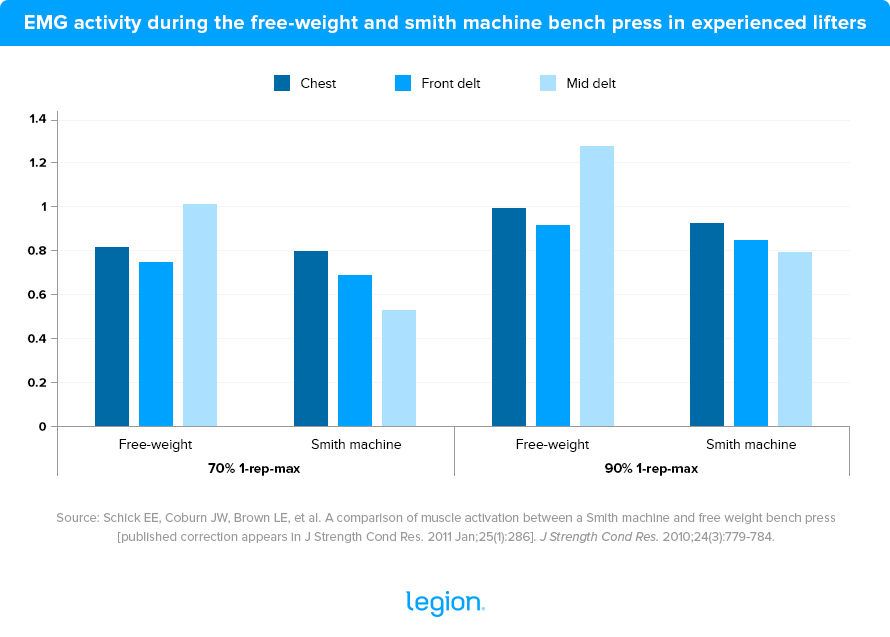Which is best for building your pecs: Smith machine bench press or barbell bench press?
Some argue that benching on a Smith machine is easier to learn, lets you lift heavier weights, and has a lower risk of injury, all of which are better for long-term gains.
The traditional counterargument is that the Smith machine bench press doesn’t train as many muscles as the free-weight variation and, thus, isn’t as good for gaining upper-body muscle and strength.
Who’s right?
That’s what scientists at California State University wanted to investigate in the following study.
What Did the Researchers Do?
The researchers had 26 weightlifters do 2 separate workouts.
In one workout, the weightlifters performed 2 reps of the flat bench press at 70% and 90% of their one-rep max. In the other workout, they followed the same rep and weight guidelines but replaced the flat bench press with the bench press on the Smith machine.
During both workouts, the researchers placed electrodes on the weightlifters’ pecs, anterior (“front”) and lateral (“side”) deltoids, and used electromyography (EMG) to measure muscle activation during each set of each exercise.
What Were the Study Results?
Muscle activation was the same in the pecs and front delts, but the barbell bench press increased side delt activation by 50% more than the Smith machine bench press.
Overall, these results back up what experienced lifters have been saying for years:
The traditional barbell bench press increases muscle activation more than the Smith machine bench press, especially in smaller stabilizer muscles that support the chest and triceps when moving heavy weights.
The reason for this is straightforward.
When you perform the bench press on the Smith machine, the bar moves on a set path throughout the entire range of motion, from the starting position when your arms are fully extended in front of you until the bar touches your torso.
Conversely, when you do a barbell bench press (or any other free-weight exercise), you have to work hard to keep the bar from deviating too far in one direction or another, and that requires many other small muscle groups to pitch in.
Remember, too, that the researchers only measured three muscles in this study. There are many other muscles that also indirectly work to help stabilize your body when bench pressing, including your lats, legs, and even your abs.
The barbell bench press may also have caused more muscle activation in these muscle groups.
This study casts doubt on another argument for benching on a Smith machine, which is that because you don’t have to stabilize the bar, you can more effectively overload the primary muscles, like the pecs.
That’s not what happened in this study.
The Smith machine didn’t cause any more muscle activation in the pecs or anterior delts, as you can see in this graph of muscle activation in the weightlifters:

What Does This Mean for You?
At first blush, these results seem to imply that the barbell bench press is better for building muscle than the Smith machine bench press.
But this isn’t necessarily true.
EMG measurements only tell us overall levels of muscle activation. While it’s reasonable to assume exercises that activate muscles to a high degree will cause more muscle growth over time, this isn’t always the case.
That said, if you had to bet on which exercise was better for muscle growth based on these results, the smart money would be on the barbell bench press.
And that’s why investing time in learning how to barbell bench press correctly often pays dividends in the long run.
None of this means benching on a Smith machine is entirely without merit.
The Smith machine bench press can be good for doing more volume (sets) for your pecs after you’re already fatigued from doing heavy free-weight presses. It’s also useful if you’re training around an injury or if you have no other equipment available.
After all, it trains most of the same muscles to a similar degree, and it’s effective at helping you gain upper-body strength.
Just don’t make the mistake of prioritizing the Smith machine bench press over free-weight alternatives, including the flat barbell and dumbbell bench press and incline barbell and dumbbell bench press.
Scientific References +
- Schick, Evan E, et al. “A Comparison of Muscle Activation between a Smith Machine and Free Weight Bench Press.” Journal of Strength and Conditioning Research, vol. 24, no. 3, Mar. 2010, pp. 779–784, https://doi.org/10.1519/jsc.0b013e3181cc2237.
- Vigotsky, Andrew D., et al. “Greater Electromyographic Responses Do Not Imply Greater Motor Unit Recruitment and “Hypertrophic Potential” Cannot Be Inferred.” Journal of Strength and Conditioning Research, vol. 31, no. 1, Jan. 2017, pp. e1–e4, https://doi.org/10.1519/jsc.0000000000001249. Accessed 15 Dec. 2021.
- Schwanbeck, Shane R., et al. “Effects of Training with Free Weights versus Machines on Muscle Mass, Strength, Free Testosterone, and Free Cortisol Levels.” Journal of Strength and Conditioning Research, vol. 34, no. 7, July 2020, pp. 1851–1859, https://doi.org/10.1519/jsc.0000000000003349. Accessed 30 Aug. 2020.










